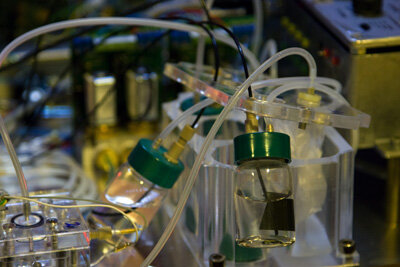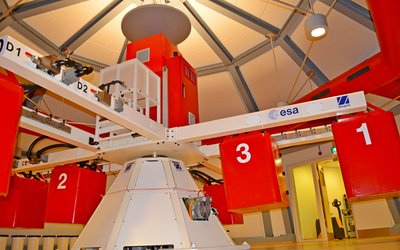Meet the teams: ETH Space Biology
Four teams of university students were selected to develop and perform their hypergravity experiments during ESA’s ‘Spin your Thesis!’ 2010 campaign. Here is an introduction to the Swiss/German team.
![]()
![]()
Voltage Clamp Studies on Living Cells under Hypergravity
![]()
![]()
| University | ETH Zurich, University of Konstanz, University of Zurich |
| Endorsing professor |
Dr. Marcel Egli Head of Space Biology Group, ETH Zurich |
| ELGRA mentor |
Prof. Dr. Jean-Francois Desaphy Associate Professor of Pharmacology, University of Bari |
| Team | Daniel Schaffhauser, Tanja Sonntag, Chiara Ghezzi |

The ETH team comprised 3 students, one from the Swiss Federal Institute of Technology in Zurich and the other two from the Universities of Konstanz and Zurich respectively. With different backgrounds, such as lab-on-chip engineering and electrophysiology, the students’ competences complement each other ideally for this project.
Manned space missions are limited by the medical problems that occur when the human body is exposed to zero gravity for extended periods. For example, to compensate for the significant muscle atrophy that occurs, astronauts must exercise for about 2.5 hours daily. To understand the underlying molecular mechanisms leading to muscle atrophy, methods are required to characterise the membrane properties of living cells under varying gravity conditions, specifically the role ion channel regulation may play in the cellular response to microgravity.
The team of students developed a self-contained system that allowed continuous recording of the electrical properties of single Xenopus oocytes, chosen because of their robustness and ease of handling. The system comprised a fully enclosed recording chamber that used microfluidics to rapidly superfuse part of the oocyte membrane.

The essential function of the setup was the measurement of the ionic currents across the cell. This was achieved by employing ion-sensitive electrodes consisting of silver and silver chloride. The lower part of the cell’s membrane could be microperfused with three different solutions. A small overpressure at the top of the cell guaranteed a tight seal of the cell against the immobilisation site.
There were three types of measurements which could be performed with the system. Current-voltage (I-V) sweeps as well as voltage step functions (employing pulse functions) could be used for measurements lasting a couple of seconds. For continuous measurements a time versus current measurement was used, with a constant holding potential. The perfusion protocol could be triggered either manually, using a timer or by the integrated G-sensor. Solution switching and electrical measurements were time-dependent on each other which guaranteed consistent measurement conditions.
The feasibility of their system had been demonstrated during parabolic flight manoeuvres. The students had overexpressed Xenopus epithelial sodium channels (ENaC) in oocytes and exposed them to cyclic changes in gravity between 1.8G and 0 G. Their data confirmed the stability and robustness of the technique and demonstrated that amiloride sensitive currents arising from heterologously expressed ENaC can be resolved under extreme changes in gravity.
The use of the Large Diameter Centrifuge allowed the system to be tested with varying gravity and time conditions. Electrophysiological studies of living cells exposed to longer periods of hypergravity was possible for the first time.
Read the final experiment report here.






